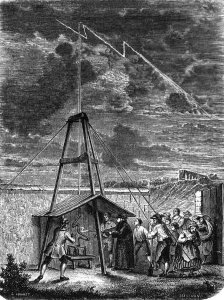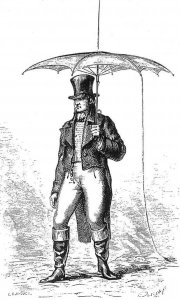Benjamin Franklin science
I.B. COHEN, Benjamin Franklin’s Science, London, 1990.
First Harvard University Press paperback edition, 1996
- Collinson’s Gift and the New German Experiments
- Prejudice against the Introduction of Lightning Rods
- Human Presumption and Divine Providence
Chapter 5, p.64-65: Collinson’s Gift and the New German Experiments
It is no derogation of the originality of Franklin’s researches to identify the experiments which he read about and then transformed into quite different experiments that yielded major new theoretical advances. In one of the experiments reported by Haller, and which Franklin would have encountered in the Gentleman’s Magazine, an electrified man stands on pitch, surrounded by others who are on the ground: “ Whoever shall approach his finger to the body of the person thus electrised will cause a spark to issue from the surface, accompanied by a crackling noise and a sudden pain of which both parties are but too sensible.” Also, “ If any other person not electrised puts his finger near one who is so,... there issues thence a fire, with a painful sensation, which both persons feel at the same time.” Franklin’s transformation was a radical one, consisting of placing two experimenters on wax insulating stands, while a third stands on the floor:
- A person standing on wax, and rubbing the tube, and another person on wax drawing the fire,they will both of them ( provided they do not stand so as to touch one another) appear to be electrised, to a person standing on the floor; that is, he will perceive a a spark on approaching each of them with his knuckle.
- But if the persons on wax touch one another during the exciting of the tube, neither of them will appear to be electrised.
- If they touch one another after exciting the tube, and drawing the fire as aforesaid, there will be a stronger spark between them than was between either of them and the person on the floor.
- After such strong spark, neither of them discover any electricity. These appearances we attempt to account for thus: We suppose, as aforesaid, that electrical fire is a common element, of which every one of the three persons above-mentioned has his equal share, before any operation is begun with the tube. A, who stands on wax and rubs the tube, collects the electrical fire from himself into the glass; and his communication with the common stock being cut off by the wax, his body is not again immediately supply’d. B, (who stands on wax likewise) passing his knuckle along near the tube, receives the fire which was collected by the glass from A; and his communication with the common stock being likewise cut off, he retains the additional quantity received.
- To C, standing on the floor, both appear to be electrised: for he having only the middle quantity of electrical fire, receives a spark upon approaching B, who has an over quantity; but he gives one to A, who has an under quantity. If A and B approach to touch each other, the spark is stronger, because the difference between them is greater : After such touch there is no spark between either of them and C, because the electrical fire in all is reduced to the original equality. If they touch while electrising, the equality is never destroy’d, the fire only circulating. Hence have arisen some new terms among us : we say B, (and the bodies like circumstanced) is electrised positively; A, negatively. Or rather, B is electrised plus; A minus. And we daily in our experiments electrised bodies plus or minus, as we think proper.
- To electrise plus or minus, no more needs to be known than this, that the parts of the tube or sphere that are rubbed, do, in the instant of the friction, attract the electrical fire, and therefore take it from the thing rubbing; the same parts immediately, as the friction upon them ceases, are disposed to give the fire they have received, to anybody that has less.
We may agree with Heilbron that “Franklin’s ingenious idea to insulate the solicitor of sparks B as well as the electrified man A transformed Haller’s little experiment into the prototypical demonstration of the existence of contrary electricities.” This example provides a striking illustration of the doctrine that the most original, and even revolutionary, innovations in science are apt to be brilliant intellectual “transformations” of existing ideas, concepts, laws, theories or experiments.
Chapter 8, p.119-120, p.121-141: Prejudice against the Introduction of Lightning Rods
Lightning Rods versus Church Bells
In reply to Winthrop’s letter about the force of prejudice preventing the adoption of lightning rods, Franklin explained that to him it did not seem quite so extraordinary the “unlearned men, such as commonly compose our church vestries” should be unacquainted with the benefits of lightning rods, or that they should still be prejudiced against the use of them, “when we see how long even philosophers, men of extensive science and great ingenuity, can hold out against the evidence of the new knowledge that does not square with their preconceptions; and how long men can retain a practice that is conformable to their prejudices, and expect a benefit from such practice, though constant experience shows its inutility.”
The practice Franklin had in mind was the practice of the ringing of church bells during a lightning storm. The practice of ringing church bells to dissipate lightning storms and prevent their deleterious effects had a long tradition in Europe and had been a concomitant to the general belief in the diabolical agency manifested in storms. Many a church bell bore an inscription testifying to the use it might have in dissipating the effects of thunder and lightning. The ritual of Paris for consecrating bells declared that “ whensoever this bell shall sound, it shall drive away the malign influences of the assailing spirits, the horror of their apparitions, the rush of whirlwinds, the stroke of lightning, the harm of thunder, the disasters of storms, and all the spirits of the tempest.” [...]
Despite the sanction given in Catholic countries to the use of bells as a means of preventing the effects of lightning, the fact was notorious by the eighteenth century that many churches were struck by lighning bolts and that many bell ringers were killed during lightning storms. In his reply to Winthrop, Franklin drew special attention to the well-known danger in attempting to use bells to ward off the effects of lightning. Franklin had been more than a little annoyed by a paper of the Abbé Nollet, published in the memoirs of the Royal French Academy of Sciences, in which he had objected to the use of metal conductors outside a building as useless or dangerous. Nollet had given many examples of the effects of lightning in churches (as well as other buildings), in which, as Franklin pointed out, the lightning “was conducted from one part [of the building] to another by wires, gildings, and other pieces of metal that were within, or connected with the building.” Among the evidence cited by Abbé Nollet was a report of M. Deslandes of 1718, describing a storm on the night of 14 April in which lightning had struck twenty-four churches between Landernau and Saint-Pol-de-Léon in Brittany; the churches struck by the lightning were the very ones in which the bells had been ringing, while the lightning had apparently spared those churches in which the bells had been silent; one church had been entirely destroyed and two of the four bell ringers had been killed.
Nollet, Franklin wrote, “cautions people not to ring the church bells during a thunder-storm, lest the lightning, in its way to the earth, should be conducted down to them by the bell ropes.” Nollet had remarked:
Bells by virtue of their benediction, should scatter the thunder-storms and preserve us from strokes of lightning; but the church permits human prudence the choice of the times when it is suitable to use this preservative. I do not know, whether sound considered physically, is capable or not of making a thunder-cloud burst and of causing the discharge of its fire towards terrestrial objects; but it is certain and proved by experience that thunder can fall on a bell-tower whether one is ringing it or whether one isn’t; and if that happens in the first case, the bell ringers are in great danger, because they pull the cord by which the commotion of the lightning can be communicated to them: it is therefore much wiser to let the bells be silent when a thunder-cloud comes over the church.
Since Nollet had carefully observed the path of lightning when buildings were struck, Franklin found it difficult to understand why he did not advocate the use of lightning rods. For, as Franklin noted, if the lightning on its way to earth could be conducted down the bell ropes, which are bad conductors, would it not be wise to offer the lightning a path through good metal conductors placed outside of the steeple, that is, lightning rods? [...]
There is no way of telling when church bells were last rung for this purpose. Indeed, for all we know, they may still be used in a vain attempt to dissipate storms in some parts of the world. The refusal of the mind to change its ways can hardly be better illustrated than by the slowness with which lightning rods were adapted to ecclesiastical structures in the eighteenth century.
Page 141: Human Presumption and Divine Providence
While we often refer to the eighteenth century as “the age of enlightenment,” we must remember that this phrase applies to the thought of leaders in the realm of the intellect, but obviously not to the vast majority of people. The prevalence of the custom of ringing church bells during storms, and the kind of antagonism to lightning rods which I discussed in the preceding section, indicate that superstition was still strong in the minds of the unenlightened.
In the volume of letters which the Abbé Nollet published in refutation of Benjamin Franklin’s electrical ideas, and in which he expressed himself so forcibly in opposition to the lightning rods, he applied himself- as Franklin wrote to his friend Cadwallader Colden on 12 April 1753 “to the superstitious prejudices of the populace, which I think unworthy of a Philosopher.”
He speaks as if he thought it Presumption in man to propose guarding himself against the Thunders of Heaven!...
Illustrations

- Abbé Nollet’s experiments
- [click on the picture to enlarge it]

- Danger of experiments

- The portable lightning conductor or Barbeu-Dubourg’s lightning conductor
- [click on the picture to enlarge it]


